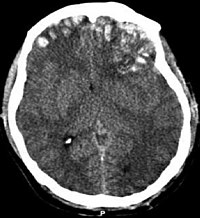
Photo from wikipedia
Background and objectives Abnormal neointimal hyperplasia (NIH) is known as the predominant mechanism in the pathogenesis of arterial restenosis after balloon angioplasty. Low shear stress (SS) is known to augment… Click to show full abstract
Background and objectives Abnormal neointimal hyperplasia (NIH) is known as the predominant mechanism in the pathogenesis of arterial restenosis after balloon angioplasty. Low shear stress (SS) is known to augment balloon injury–induced NIH. The aim of this study is to study the effect and mechanisms of an increase of shear stress caused by arteriovenous fistula could alleviate arterial NIH caused by balloon injury. Methods and results Eighteen male rabbits were randomly divided into three groups: BI—the rabbits received a balloon injury to right common carotid artery (CCA). BI+AVF—the rabbits received a balloon injury to right CCA and a carotid–jugular AVF. Control—the animals received no surgery. After 21 days, CCA samples were harvested for histological staining, immunohistochemistry, and western blot analysis. The luminal shear stress of the BI+AVF group increased from 13.8 ± 1.0 dyn/cm2 before surgery to 30.9 ± 1.7 dyn/cm2 right after surgery (p < 0.01). This value was higher than that of the BI or Control groups at any timepoint. The neointimal area and neointima/media area ratio in the BI+AVF group were significantly lower than those in the BI group. In the BI group, the cellular proliferation, the protein levels of yes-associated protein (YAP), connective tissue growth factor (CTGF), phospho-c-Jun N-terminal kinase (pJNK), and vascular cell adhesion protein 1 (VCAM1) increased, whereas the protein levels of SMCs specific genes decreased. In the BI+AVF group, the opposite effect was observed as cellular proliferation and the protein levels of YAP, CTGF, pJNK, and VCAM1 decreased, the protein levels of SMCs specific genes increased. Conclusion The arteriovenous fistula alleviated the balloon injury–induced arterial NIH. It elevated the luminal shear stress and inhibited SMCs phenotypic modulation to the synthetic state, as well as suppressing the over-activation of YAP, JNK, and VCAM1.
Journal Title: Vascular
Year Published: 2022
Link to full text (if available)
Share on Social Media: Sign Up to like & get
recommendations!